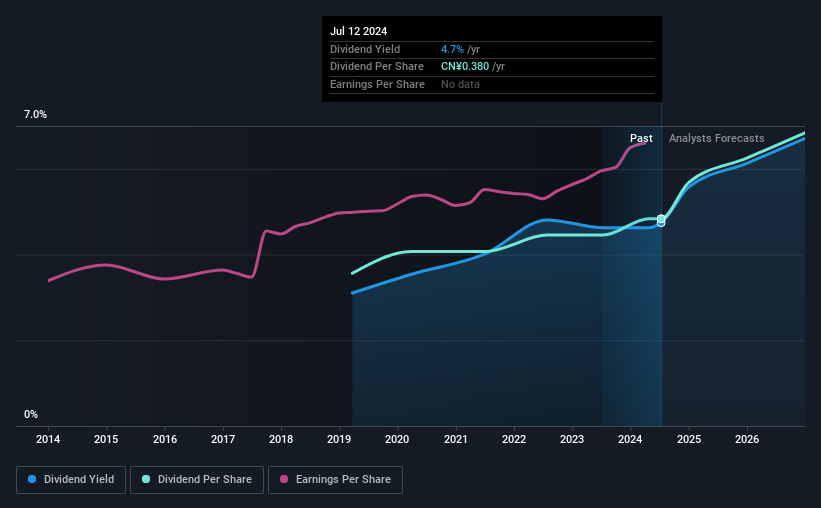Bank of Changsha Co., Ltd. (SHSE:601577) Looks Like A Good Stock, And It's Going Ex-Dividend Soon

Bank of Changsha Co., Ltd. (SHSE:601577) is about to trade ex-dividend in the next three days. The ex-dividend date is one business day before the record date, which is the cut-off date for shareholders to be present on the company's books to be eligible for a dividend payment. The ex-dividend date is of consequence because whenever a stock is bought or sold, the trade takes at least two business day to settle. Therefore, if you purchase Bank of Changsha's shares on or after the 16th of July, you won't be eligible to receive the dividend, when it is paid on the 16th of July.
The company's next dividend payment will be CN¥0.38 per share, on the back of last year when the company paid a total of CN¥0.38 to shareholders. Looking at the last 12 months of distributions, Bank of Changsha has a trailing yield of approximately 4.7% on its current stock price of CN¥8.01. We love seeing companies pay a dividend, but it's also important to be sure that laying the golden eggs isn't going to kill our golden goose! So we need to investigate whether Bank of Changsha can afford its dividend, and if the dividend could grow.
See our latest analysis for Bank of Changsha
Dividends are usually paid out of company profits, so if a company pays out more than it earned then its dividend is usually at greater risk of being cut. Bank of Changsha is paying out just 20% of its profit after tax, which is comfortably low and leaves plenty of breathing room in the case of adverse events.
Companies that pay out less in dividends than they earn in profits generally have more sustainable dividends. The lower the payout ratio, the more wiggle room the business has before it could be forced to cut the dividend.
Click here to see the company's payout ratio, plus analyst estimates of its future dividends.

Have Earnings And Dividends Been Growing?
Businesses with strong growth prospects usually make the best dividend payers, because it's easier to grow dividends when earnings per share are improving. Investors love dividends, so if earnings fall and the dividend is reduced, expect a stock to be sold off heavily at the same time. With that in mind, we're encouraged by the steady growth at Bank of Changsha, with earnings per share up 5.8% on average over the last five years.
The main way most investors will assess a company's dividend prospects is by checking the historical rate of dividend growth. In the past five years, Bank of Changsha has increased its dividend at approximately 6.3% a year on average. It's encouraging to see the company lifting dividends while earnings are growing, suggesting at least some corporate interest in rewarding shareholders.
Final Takeaway
From a dividend perspective, should investors buy or avoid Bank of Changsha? Bank of Changsha has seen its earnings per share grow slowly in recent years, and the company reinvests more than half of its profits in the business, which generally bodes well for its future prospects. Bank of Changsha ticks a lot of boxes for us from a dividend perspective, and we think these characteristics should mark the company as deserving of further attention.
In light of that, while Bank of Changsha has an appealing dividend, it's worth knowing the risks involved with this stock. For example - Bank of Changsha has 1 warning sign we think you should be aware of.
A common investing mistake is buying the first interesting stock you see. Here you can find a full list of high-yield dividend stocks.
Valuation is complex, but we're here to simplify it.
Discover if Bank of Changsha might be undervalued or overvalued with our detailed analysis, featuring fair value estimates, potential risks, dividends, insider trades, and its financial condition.
Access Free AnalysisHave feedback on this article? Concerned about the content? Get in touch with us directly. Alternatively, email editorial-team (at) simplywallst.com.
This article by Simply Wall St is general in nature. We provide commentary based on historical data and analyst forecasts only using an unbiased methodology and our articles are not intended to be financial advice. It does not constitute a recommendation to buy or sell any stock, and does not take account of your objectives, or your financial situation. We aim to bring you long-term focused analysis driven by fundamental data. Note that our analysis may not factor in the latest price-sensitive company announcements or qualitative material. Simply Wall St has no position in any stocks mentioned.
Have feedback on this article? Concerned about the content? Get in touch with us directly. Alternatively, email editorial-team@simplywallst.com
About SHSE:601577
Bank of Changsha
Provides various commercial banking products and services to personal and business customers in China.
Very undervalued with flawless balance sheet and pays a dividend.

